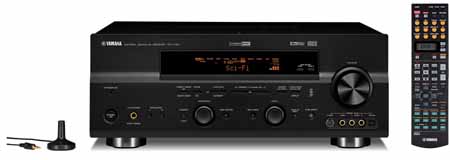Satellite Radio Meets the A/V Receiver
 My mistake was that I hadn't taken into account the tediously mind-numbing hit-your-brain-with-a-blunt-instrument nature of commercial radio today. Over four million fed up listeners, however, were smarter than I and have signed up for one of the two subscription radio services (3+ million for XM and 1+ million for Sirius so far). For the measly sum of $13 per month (more if you want to enjoy "premium" channels), drivers - and now home listeners - all over the country are listening to a wide variety of commercial-free channels offering standard and eclectic music, sports, and information. Realizing my mistake in judgement, it wasn't long before I succumbed to the lure of digital sky-down radio and installed an XM tuner in my wife's car.
My mistake was that I hadn't taken into account the tediously mind-numbing hit-your-brain-with-a-blunt-instrument nature of commercial radio today. Over four million fed up listeners, however, were smarter than I and have signed up for one of the two subscription radio services (3+ million for XM and 1+ million for Sirius so far). For the measly sum of $13 per month (more if you want to enjoy "premium" channels), drivers - and now home listeners - all over the country are listening to a wide variety of commercial-free channels offering standard and eclectic music, sports, and information. Realizing my mistake in judgement, it wasn't long before I succumbed to the lure of digital sky-down radio and installed an XM tuner in my wife's car.
I can say from personal experience that once you've listened to satellite radio on the road, it's not long before you want it at home. Until now, though, satellite radio wasn't very convenient to add on to your home entertainment system. You're choices were either to buy a home kit that provided the ability to carry your receiver from the car and connect it to your home audio system (inconvenient and terribly annoying when you forget to grab it before leaving for work in the morning), or (more convenient but also more expensive) purchase a home audio component satellite radio tuner, such as Polk's exceptional XRt12 XM Reference Tuner.
 Now, however, Yamaha and XM Radio are making satellite radio at home as easy (or easier) than in your automobile - and very affordable. Starting in April, 2005, Yamaha will offer four new receivers and a few home-theater-in-a-box (HTiB) systems with XM "Connect-and-Play" technology. XM says the new technology is designed to integrate XM into a broad range of home entertainment products, and Yamaha claims that the inclusion of XM's "Connect-and-Play" circuitry makes them the first company to incorporate satellite radio into their A/V receivers.
Now, however, Yamaha and XM Radio are making satellite radio at home as easy (or easier) than in your automobile - and very affordable. Starting in April, 2005, Yamaha will offer four new receivers and a few home-theater-in-a-box (HTiB) systems with XM "Connect-and-Play" technology. XM says the new technology is designed to integrate XM into a broad range of home entertainment products, and Yamaha claims that the inclusion of XM's "Connect-and-Play" circuitry makes them the first company to incorporate satellite radio into their A/V receivers.
 With the new XM-ready Yamaha A/V receivers, all you need to receive XM Radio's 150-plus channels is plug in an XM Connect-and-Play home antenna - and sign up for a subscription, of course. The optional $49.95 MSRP XM antenna is the only accessory required to fire up the XM capabilities of the new Yamaha receivers and HTiB systems.
With the new XM-ready Yamaha A/V receivers, all you need to receive XM Radio's 150-plus channels is plug in an XM Connect-and-Play home antenna - and sign up for a subscription, of course. The optional $49.95 MSRP XM antenna is the only accessory required to fire up the XM capabilities of the new Yamaha receivers and HTiB systems.
The four XM-Ready Yamaha receivers include two 7.1-channel models, the RX-V757 (100 watts x 7, $649.95 MSRP) and the RX-V657 (95 watts x 7, $549.95 MSRP), as well as two 6.1-channel units, the RX-V557 (90 watts x 6, $449.95 MSRP) and the RX-V457 (85 watts x 6, $349.95 MSRP). Yamaha will also release four XM-Ready receivers in their HTR-series (ranging from $349.95 to $849.95), which are typically found in mass-merchant stores. In addition, Yamaha says they'll include the XM-Ready feature in several HTiB YHT-series systems.

- Log in or register to post comments





























































